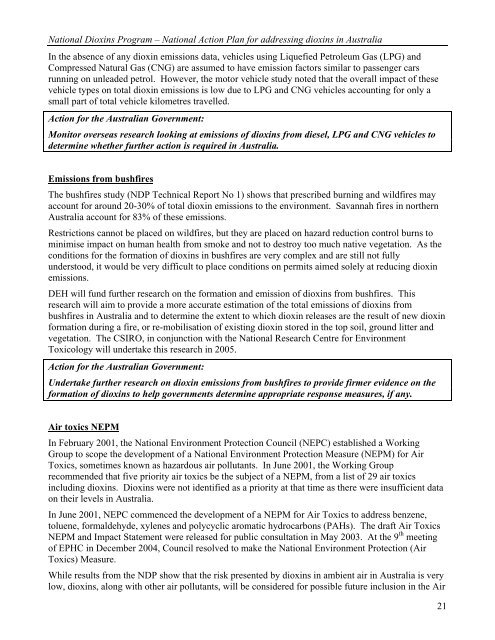National Action Plan for Addressing Dioxins in Australia
National Action Plan for Addressing Dioxins in Australia
National Action Plan for Addressing Dioxins in Australia
- No tags were found...
You also want an ePaper? Increase the reach of your titles
YUMPU automatically turns print PDFs into web optimized ePapers that Google loves.
<strong>National</strong> <strong>Diox<strong>in</strong>s</strong> Program – <strong>National</strong> <strong>Action</strong> <strong>Plan</strong> <strong>for</strong> address<strong>in</strong>g diox<strong>in</strong>s <strong>in</strong> <strong>Australia</strong>In the absence of any diox<strong>in</strong> emissions data, vehicles us<strong>in</strong>g Liquefied Petroleum Gas (LPG) andCompressed Natural Gas (CNG) are assumed to have emission factors similar to passenger carsrunn<strong>in</strong>g on unleaded petrol. However, the motor vehicle study noted that the overall impact of thesevehicle types on total diox<strong>in</strong> emissions is low due to LPG and CNG vehicles account<strong>in</strong>g <strong>for</strong> only asmall part of total vehicle kilometres travelled.<strong>Action</strong> <strong>for</strong> the <strong>Australia</strong>n Government:Monitor overseas research look<strong>in</strong>g at emissions of diox<strong>in</strong>s from diesel, LPG and CNG vehicles todeterm<strong>in</strong>e whether further action is required <strong>in</strong> <strong>Australia</strong>.Emissions from bushfiresThe bushfires study (NDP Technical Report No 1) shows that prescribed burn<strong>in</strong>g and wildfires mayaccount <strong>for</strong> around 20-30% of total diox<strong>in</strong> emissions to the environment. Savannah fires <strong>in</strong> northern<strong>Australia</strong> account <strong>for</strong> 83% of these emissions.Restrictions cannot be placed on wildfires, but they are placed on hazard reduction control burns tom<strong>in</strong>imise impact on human health from smoke and not to destroy too much native vegetation. As theconditions <strong>for</strong> the <strong>for</strong>mation of diox<strong>in</strong>s <strong>in</strong> bushfires are very complex and are still not fullyunderstood, it would be very difficult to place conditions on permits aimed solely at reduc<strong>in</strong>g diox<strong>in</strong>emissions.DEH will fund further research on the <strong>for</strong>mation and emission of diox<strong>in</strong>s from bushfires. Thisresearch will aim to provide a more accurate estimation of the total emissions of diox<strong>in</strong>s frombushfires <strong>in</strong> <strong>Australia</strong> and to determ<strong>in</strong>e the extent to which diox<strong>in</strong> releases are the result of new diox<strong>in</strong><strong>for</strong>mation dur<strong>in</strong>g a fire, or re-mobilisation of exist<strong>in</strong>g diox<strong>in</strong> stored <strong>in</strong> the top soil, ground litter andvegetation. The CSIRO, <strong>in</strong> conjunction with the <strong>National</strong> Research Centre <strong>for</strong> EnvironmentToxicology will undertake this research <strong>in</strong> 2005.<strong>Action</strong> <strong>for</strong> the <strong>Australia</strong>n Government:Undertake further research on diox<strong>in</strong> emissions from bushfires to provide firmer evidence on the<strong>for</strong>mation of diox<strong>in</strong>s to help governments determ<strong>in</strong>e appropriate response measures, if any.Air toxics NEPMIn February 2001, the <strong>National</strong> Environment Protection Council (NEPC) established a Work<strong>in</strong>gGroup to scope the development of a <strong>National</strong> Environment Protection Measure (NEPM) <strong>for</strong> AirToxics, sometimes known as hazardous air pollutants. In June 2001, the Work<strong>in</strong>g Grouprecommended that five priority air toxics be the subject of a NEPM, from a list of 29 air toxics<strong>in</strong>clud<strong>in</strong>g diox<strong>in</strong>s. <strong>Diox<strong>in</strong>s</strong> were not identified as a priority at that time as there were <strong>in</strong>sufficient dataon their levels <strong>in</strong> <strong>Australia</strong>.In June 2001, NEPC commenced the development of a NEPM <strong>for</strong> Air Toxics to address benzene,toluene, <strong>for</strong>maldehyde, xylenes and polycyclic aromatic hydrocarbons (PAHs). The draft Air ToxicsNEPM and Impact Statement were released <strong>for</strong> public consultation <strong>in</strong> May 2003. At the 9 th meet<strong>in</strong>gof EPHC <strong>in</strong> December 2004, Council resolved to make the <strong>National</strong> Environment Protection (AirToxics) Measure.While results from the NDP show that the risk presented by diox<strong>in</strong>s <strong>in</strong> ambient air <strong>in</strong> <strong>Australia</strong> is verylow, diox<strong>in</strong>s, along with other air pollutants, will be considered <strong>for</strong> possible future <strong>in</strong>clusion <strong>in</strong> the Air21
















